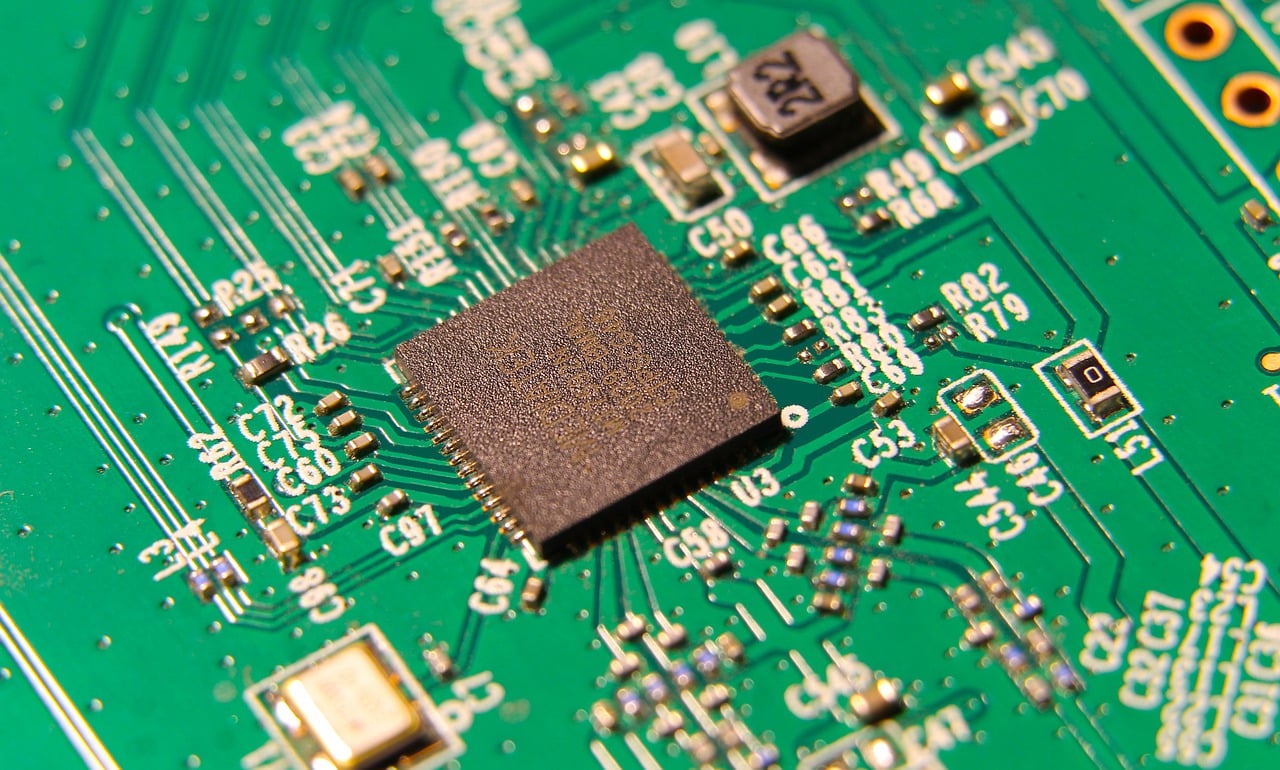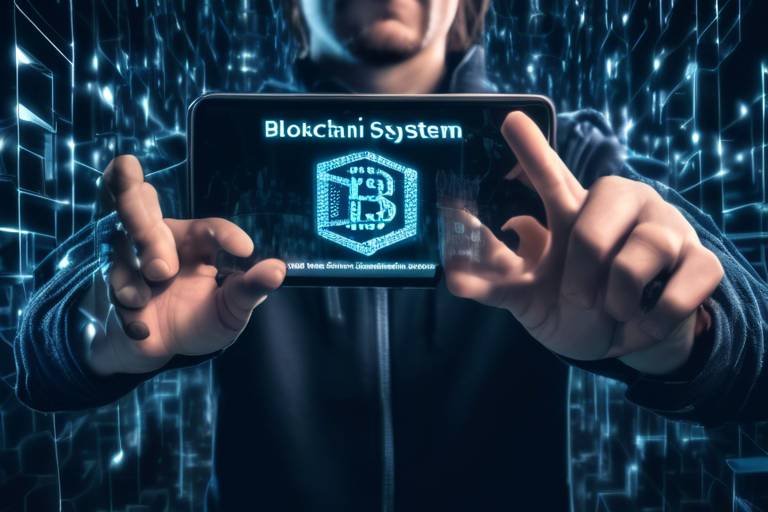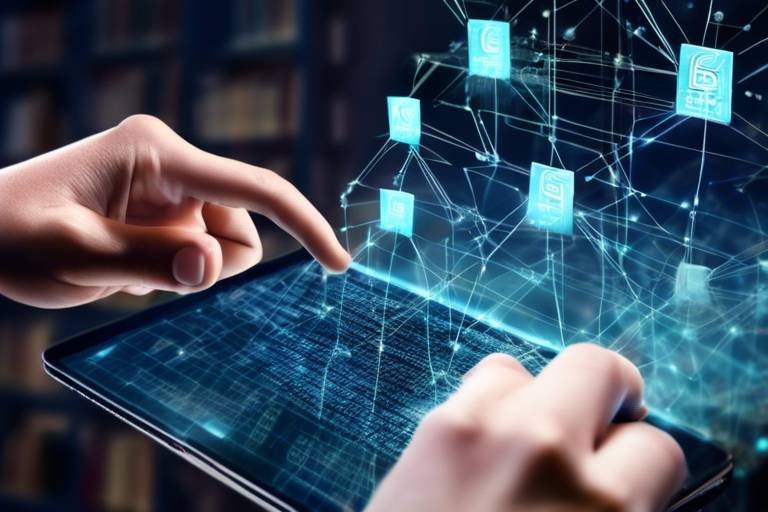How Blockchain is Impacting Intellectual Property Rights
In today's fast-paced digital world, where creativity and innovation are the lifeblood of industries, the protection of intellectual property rights (IPR) has become more crucial than ever. Traditional systems often struggle to keep pace with the rapid evolution of technology, leaving creators vulnerable to theft and misuse of their work. Enter blockchain technology, a game-changer that promises to revolutionize how we manage and protect intellectual property. By leveraging its decentralized nature, blockchain not only enhances the security of IPR but also streamlines processes, reduces costs, and fosters a culture of innovation. So, how exactly is blockchain impacting intellectual property rights? Let’s dive in!
Intellectual property rights (IPR) are legal protections granted to creators for their inventions, artistic works, and designs. These rights are essential for encouraging innovation, as they ensure that creators can reap the rewards of their efforts. There are several types of IPR, including copyrights, patents, trademarks, and trade secrets. Each type serves a distinct purpose:
| Type of IPR | Description |
|---|---|
| Copyright | Protects original works of authorship, such as books, music, and art. |
| Patent | Grants exclusive rights to inventors for their inventions, preventing others from making, using, or selling the invention without permission. |
| Trademark | Protects symbols, names, and slogans used to identify goods or services. |
| Trade Secret | Protects confidential business information that provides a competitive edge. |
Despite their importance, traditional IPR systems face numerous challenges, such as lengthy registration processes, high costs, and difficulties in enforcement. These issues can hinder innovation and discourage creators from pursuing their ideas. This is where blockchain technology comes into play.
At its core, blockchain is a decentralized digital ledger that records transactions across multiple computers. This ensures that the data is transparent, secure, and immutable. Each block in the chain contains a list of transactions, and once a block is added to the chain, it cannot be altered. This level of security and transparency is what makes blockchain particularly appealing for managing intellectual property rights. It allows for real-time tracking of ownership and usage, reducing the risk of infringement and misuse.
One of the most exciting applications of blockchain in the realm of intellectual property is the use of smart contracts. These are self-executing contracts with the terms of the agreement directly written into code. Smart contracts can automate and enforce agreements in real-time, making them a powerful tool for managing licensing and royalty distribution.
Smart contracts offer several key advantages for protecting intellectual property rights:
- Reduced Transaction Costs: By eliminating intermediaries, smart contracts can significantly lower transaction fees.
- Enhanced Security: The decentralized nature of blockchain ensures that contracts are tamper-proof and easily verifiable.
- Faster Transactions: Automation speeds up the execution of agreements, allowing for quicker royalty payments and licensing arrangements.
However, the implementation of smart contracts is not without its challenges. Legal and technical hurdles can arise, such as:
- Legal Recognition: Many jurisdictions have yet to fully recognize smart contracts as legally binding.
- Technical Complexity: The creation and management of smart contracts require specialized knowledge, which can be a barrier for some users.
Despite these challenges, the potential benefits of smart contracts for intellectual property management are undeniable.
Another innovative aspect of blockchain technology is the tokenization of intellectual property. This process involves converting IP assets into digital tokens that can be bought, sold, or traded on blockchain platforms. Tokenization enhances liquidity and accessibility for both IP owners and investors, opening up new avenues for monetization and investment in creative works.
Decentralized platforms are emerging as powerful tools for managing intellectual property rights more efficiently. These platforms leverage blockchain technology to provide transparent and secure environments for IP transactions, enabling creators to protect and monetize their work without relying on traditional intermediaries. Some notable platforms include:
- Myco: A platform that allows creators to register their works and receive royalties through blockchain technology.
- Ascribe: This service helps artists establish ownership of their digital works through blockchain registration.
Real-world examples of blockchain implementations in intellectual property illustrate its potential to address IPR issues. For instance, a well-known musician used blockchain to manage her music rights, ensuring that all parties involved received fair compensation for their contributions. These case studies provide valuable insights into the practical applications of blockchain in the IPR landscape.
The intersection of blockchain and intellectual property is evolving rapidly. As technology advances, we can anticipate several trends that may shape the future of IPR:
- Increased Adoption: More creators and businesses will embrace blockchain for IP management.
- Regulatory Developments: Governments will likely introduce regulations to address the legal aspects of blockchain and smart contracts.
- Innovative Solutions: New platforms and tools will emerge, offering even more efficient ways to protect and monetize intellectual property.
1. What is blockchain technology?
Blockchain technology is a decentralized digital ledger that records transactions across multiple computers, ensuring transparency and security.
2. How can blockchain protect intellectual property rights?
Blockchain enhances the security of IPR by providing a transparent and immutable record of ownership and usage, reducing the risk of infringement.
3. What are smart contracts?
Smart contracts are self-executing contracts with the terms of the agreement written into code, allowing for automated and real-time enforcement of agreements.
4. What is tokenization of intellectual property?
Tokenization involves converting IP assets into digital tokens that can be traded on blockchain platforms, enhancing liquidity and accessibility for IP owners and investors.
5. What challenges do smart contracts face?
Smart contracts face challenges such as legal recognition and technical complexity, which can hinder widespread adoption.

Understanding Intellectual Property Rights
Intellectual property rights (IPR) are essential in today's creative economy, acting as a shield for creators and innovators. They cover a wide array of creations, from inventions and literary works to designs and symbols. In essence, IPR grants creators exclusive rights to their work, allowing them to control how it is used and monetized. This protection is crucial for fostering an environment where creativity can flourish, providing the motivation for inventors and artists to bring their ideas to life.
There are several types of IPR, each serving a unique purpose:
- Patents: These protect inventions and grant the inventor exclusive rights to use and commercialize their invention for a specific period, usually 20 years.
- Copyrights: These safeguard original works of authorship, such as books, music, and films, ensuring that creators have control over the reproduction and distribution of their works.
- Trademarks: These protect symbols, names, and slogans used to identify goods or services, helping consumers distinguish between different brands.
- Trade Secrets: These cover confidential business information that provides a competitive edge, such as formulas, practices, or processes.
The significance of IPR cannot be overstated. In a world where ideas are exchanged at lightning speed, having a robust protection mechanism encourages innovation and creativity. However, traditional systems often face challenges, such as lengthy registration processes, high costs, and difficulties in enforcement. Creators may find themselves in a complex web of legalities that can inhibit their ability to protect their work effectively.
Moreover, the global nature of the internet complicates IPR enforcement, as laws can vary significantly from one jurisdiction to another. This inconsistency can lead to unauthorized use of intellectual property, undermining the rights of creators and potentially stifling innovation. With the rise of digital platforms, the need for an efficient and transparent system to manage IPR has never been more pressing, paving the way for innovative solutions like blockchain technology.
In conclusion, understanding intellectual property rights is crucial for anyone involved in creative endeavors. As we delve deeper into the transformative effects of blockchain on IPR, it becomes clear that this technology has the potential to address many of the challenges faced by traditional systems, creating a more equitable and efficient landscape for creators.

Introduction to Blockchain Technology
Blockchain technology has emerged as a revolutionary force in the digital landscape, fundamentally altering how we perceive and manage data. At its core, a blockchain is a decentralized digital ledger that records transactions across many computers in such a way that the registered transactions cannot be altered retroactively. This characteristic not only ensures the integrity of the data but also enhances transparency and security in various applications, including intellectual property rights.
Imagine a world where every piece of creative work—from a catchy jingle to a groundbreaking invention—is securely documented and easily accessible. Blockchain technology makes this possible by creating an immutable record of ownership and transaction history. This means that once a piece of intellectual property (IP) is registered on the blockchain, it is virtually impossible to tamper with or erase that record. As a result, creators can enjoy a newfound sense of security over their work, knowing that their rights are protected by a robust system.
The fundamental principles of blockchain revolve around three key components: decentralization, transparency, and security. Let's break these down:
- Decentralization: Unlike traditional databases that are controlled by a single entity, blockchain operates on a peer-to-peer network. This means that no single party has control over the entire database, reducing the risk of fraud and manipulation.
- Transparency: All transactions on the blockchain are visible to all participants in the network. This transparency fosters trust among users, as anyone can verify the authenticity of a transaction.
- Security: Blockchain utilizes cryptographic techniques to secure data. Each transaction is encrypted and linked to the previous transaction, creating a chain of blocks that is incredibly difficult to alter.
These principles set the stage for blockchain's application in intellectual property rights. By leveraging this technology, creators can streamline the registration process, manage licenses more efficiently, and ensure that their rights are upheld without the need for intermediaries. For instance, when an artist uploads a new song to a blockchain-based platform, the ownership details are automatically recorded, along with the terms of use and distribution rights. This not only simplifies the licensing process but also ensures that artists receive fair compensation for their work.
Moreover, blockchain technology has the potential to reduce disputes over ownership and copyright infringement. In a traditional system, proving ownership can often be a tedious and convoluted process. However, with blockchain, the proof of ownership is as simple as accessing a digital record. This could lead to a substantial decrease in legal battles over intellectual property, saving time and resources for both creators and consumers.
As we delve deeper into the implications of blockchain technology for intellectual property rights, it becomes clear that this innovation is not just a passing trend. It represents a significant shift in how we think about ownership and rights in the digital age. The potential for enhanced protection, streamlined processes, and increased innovation is immense, paving the way for a new era of creativity and collaboration.

Smart Contracts and IPR
In the rapidly evolving landscape of intellectual property rights (IPR), smart contracts are emerging as a game-changing tool that can significantly streamline the management and enforcement of these rights. But what exactly are smart contracts? Simply put, they are self-executing contracts with the terms of the agreement directly written into code. This means that once the conditions are met, the contract executes automatically without the need for intermediaries. Imagine a vending machine: you insert money, select your item, and the machine delivers it without needing a cashier. That's the beauty of smart contracts!
When we look at IPR, the potential applications of smart contracts are both exciting and transformative. They can automate licensing agreements, ensuring that creators receive their royalties in real-time as their work is used. For instance, consider a musician whose tracks are streamed on a platform. With smart contracts, every time a song is played, a small payment can automatically be sent to the artist’s digital wallet. This not only ensures timely payments but also enhances transparency in the distribution process.
Moreover, smart contracts can help in managing complex licensing agreements. Traditionally, these agreements can be cumbersome and often lead to disputes over terms. However, with smart contracts, the terms are clear and immutable, significantly reducing the chances of misunderstandings. This clarity can foster a more collaborative environment between creators and distributors, allowing for innovative partnerships that might not have been feasible before.
Nonetheless, while the advantages of smart contracts are substantial, they are not without their challenges. Legal recognition of smart contracts varies by jurisdiction, and there are concerns regarding the enforceability of these contracts in traditional legal frameworks. Additionally, the technical complexities involved in creating and executing smart contracts can pose significant barriers for many creators who may not have the technical expertise to navigate blockchain technology.
To illustrate the impact of smart contracts on IPR, let's consider a hypothetical scenario involving an artist and a digital art marketplace. The artist creates a piece of digital art and wants to sell it as a non-fungible token (NFT). By using a smart contract, the artist can set the terms of sale, including the price and any royalties for future sales. Once the NFT is purchased, the smart contract automatically transfers ownership and ensures that the artist receives a percentage of any future sales, all without requiring a third party to oversee the transaction. This not only empowers the artist but also promotes a fairer and more efficient marketplace.
In conclusion, smart contracts hold immense potential to revolutionize the way intellectual property is managed and protected. They offer a level of efficiency, transparency, and security that traditional methods simply cannot match. As we continue to explore the intersection of technology and intellectual property, it is crucial for creators, businesses, and legal professionals to stay informed about these developments and consider how they can leverage smart contracts to their advantage.

Benefits of Smart Contracts
Smart contracts stand at the forefront of revolutionizing how we manage intellectual property rights, bringing a myriad of benefits that make them incredibly appealing for creators and businesses alike. Imagine a world where agreements are executed automatically, without the need for intermediaries, and where transparency is guaranteed. That's the promise of smart contracts! They are essentially self-executing contracts with the terms of the agreement directly written into code. This not only streamlines processes but also significantly reduces the time and cost associated with traditional contract management.
One of the most significant advantages of smart contracts is their ability to eliminate intermediaries. In the traditional IP landscape, creators often rely on agents or legal representatives to manage their rights and royalties. This can lead to delays, miscommunication, and additional costs. With smart contracts, these middlemen are rendered unnecessary. The contract executes itself when predefined conditions are met, which means that creators can receive their royalties almost instantly, without worrying about whether someone else is taking a cut.
Moreover, the transparency offered by smart contracts enhances trust among all parties involved. Since the contract is stored on the blockchain, every transaction is visible and immutable. This means that once a contract is executed, it cannot be altered or tampered with. For instance, if a musician licenses a song, both the artist and the licensee can see the transaction details, ensuring that everyone is on the same page. This level of transparency can significantly reduce disputes, as all parties have access to the same information.
Additionally, smart contracts can be programmed to handle complex licensing agreements. For example, if a piece of artwork is used in multiple projects, a smart contract can automatically calculate and distribute royalties based on usage metrics, ensuring that artists are fairly compensated for their work. This capability not only simplifies the process but also encourages innovation, as creators feel more secure in sharing their work.
However, while the benefits of smart contracts are numerous, it’s essential to recognize that they also come with their own set of challenges. Nevertheless, the potential for enhancing efficiency, reducing costs, and fostering trust in the management of intellectual property rights is truly remarkable.
- What are smart contracts? Smart contracts are self-executing contracts with the terms written directly into code, enabling automatic execution when conditions are met.
- How do smart contracts benefit intellectual property? They reduce the need for intermediaries, enhance transparency, and streamline the management of IP rights.
- Are there any risks associated with smart contracts? Yes, there are legal and technical challenges that can arise, such as coding errors or regulatory issues.
- Can smart contracts handle complex agreements? Absolutely! Smart contracts can be programmed to manage intricate licensing and royalty distribution efficiently.

Challenges of Smart Contracts
While smart contracts offer a revolutionary approach to managing intellectual property rights, they are not without their challenges. One of the most significant hurdles is the legal recognition of smart contracts. Many jurisdictions still grapple with the legal status of these digital agreements. Without clear regulations, the enforceability of smart contracts can be called into question, leaving creators and innovators in a precarious position. Imagine signing a digital contract that no one recognizes in court—it's a recipe for chaos!
Moreover, technical challenges abound. Smart contracts rely heavily on the underlying blockchain technology, which can be complex and prone to vulnerabilities. For instance, if there are bugs in the code or unforeseen circumstances that the contract does not account for, it could lead to unintended consequences. This raises the question: how do we ensure that smart contracts are both secure and adaptable to changing conditions? The answer lies in rigorous testing and continuous updates, but that requires a level of expertise that not all creators possess.
Another challenge is the issue of interoperability. Different blockchain platforms may not easily communicate with each other, creating silos that can hinder the seamless transfer and management of intellectual property rights. For instance, if an artist's work is tokenized on one platform but they want to sell it on another, the lack of interoperability could complicate the process significantly. This fragmentation can confuse users and lead to a lack of trust in the system.
Additionally, there are concerns regarding data privacy. While blockchain is known for its transparency, this can be a double-edged sword. Intellectual property owners may be hesitant to fully disclose their creations on a public ledger for fear of theft or misuse. Striking a balance between transparency and privacy is crucial, yet challenging.
Lastly, the cost of implementation can be prohibitive for many creators, especially independent artists and small businesses. Setting up smart contracts requires not only technical knowledge but also financial investment in blockchain infrastructure. This can create a barrier to entry, limiting the benefits of smart contracts to those who can afford them. In a world where innovation should be accessible to all, this is a significant drawback.
In summary, while smart contracts hold immense potential for transforming the landscape of intellectual property rights, they also come with a set of challenges that need to be addressed. From legal recognition to technical hurdles and privacy concerns, navigating the world of smart contracts requires careful consideration and strategic planning.
- What are smart contracts? Smart contracts are self-executing contracts with the terms of the agreement directly written into code on a blockchain.
- How do smart contracts benefit intellectual property rights? They automate agreements, reduce transaction costs, and eliminate the need for intermediaries.
- What are the main challenges of using smart contracts? Legal recognition, technical vulnerabilities, interoperability issues, data privacy concerns, and implementation costs.
- Can smart contracts be modified once deployed? Generally, smart contracts are immutable, meaning they cannot be changed once deployed, which can be a limitation.

Tokenization of Intellectual Property
Tokenization of intellectual property (IP) is a groundbreaking process that converts IP assets into digital tokens. Imagine your favorite song or artwork being transformed into a unique digital asset that can be bought, sold, or traded just like stocks. This innovative approach not only enhances the liquidity of IP assets but also democratizes access for investors and creators alike. By representing IP rights as tokens on a blockchain, we can create a transparent and secure marketplace where ownership and transactions are easily verifiable.
One of the most exciting aspects of tokenization is its potential to streamline the way we manage and monetize intellectual property. For instance, artists and creators can tokenize their works, allowing them to sell fractional ownership to multiple investors. This means that instead of a single buyer owning the entire piece, several people can own a share, thus increasing the potential revenue for the creator. Additionally, this model opens up new avenues for investment, making it easier for individuals to participate in the IP market without needing substantial capital.
Moreover, tokenization can significantly reduce administrative burdens. Traditionally, managing IP rights involves a myriad of paperwork, legal agreements, and intermediaries, which can be both time-consuming and costly. With tokenized assets, all transactions are recorded on a blockchain, providing a clear, immutable record of ownership and transfer. This level of transparency not only protects creators but also instills confidence in investors, as they can easily trace the history of an asset.
However, while the benefits of tokenization are substantial, there are also challenges to consider. The legal landscape surrounding tokenized IP is still evolving, and there are questions about how existing laws apply to digital tokens. For instance, how do we classify tokenized assets? Are they securities, or do they fall under different legal categories? These questions must be addressed to ensure that both creators and investors are protected.
Furthermore, the technology behind tokenization must be robust and user-friendly. If the process of buying, selling, or trading tokenized IP is too complicated, it may deter potential users from engaging with the system. Therefore, education and outreach will be crucial in promoting the adoption of tokenized intellectual property.
In summary, the tokenization of intellectual property represents a significant shift in how we think about ownership and value in the creative industries. By leveraging blockchain technology, we can create a more inclusive and efficient marketplace for IP assets. As we continue to explore this innovative frontier, it is essential to navigate the legal and technological challenges carefully to unlock the full potential of tokenization.
- What is tokenization? Tokenization is the process of converting an asset into a digital token that can be traded or sold on a blockchain.
- How does tokenization benefit creators? It allows creators to sell fractional ownership of their work, increasing revenue opportunities and reducing administrative burdens.
- Are tokenized IP assets legally protected? The legal framework for tokenized assets is still developing, and it's important for creators and investors to stay informed about relevant laws.
- Can anyone invest in tokenized IP? Yes, tokenization democratizes access, allowing individuals to invest in IP assets without needing significant capital.

Decentralized Platforms for IP Management
Decentralized platforms are revolutionizing the way intellectual property (IP) is managed in today's digital landscape. By leveraging blockchain technology, these platforms offer a transparent, secure, and efficient method for creators to protect and monetize their intellectual property. Imagine a world where artists, inventors, and creators can directly engage with their audience without the need for intermediaries—this is the promise that decentralized platforms hold.
One of the most significant advantages of these platforms is their ability to provide a transparent record of ownership and transaction history. Every time an IP asset changes hands, the transaction is recorded on the blockchain, creating an immutable ledger that can be accessed by anyone. This transparency not only helps in establishing rightful ownership but also significantly reduces the chances of copyright infringement and fraud.
Moreover, decentralized platforms often utilize smart contracts to automate various processes associated with IP management. For instance, when a creator licenses their work, a smart contract can automatically execute the terms of the agreement, ensuring that royalties are distributed fairly and promptly. This automation not only saves time but also minimizes disputes that can arise from miscommunication or human error.
Additionally, these platforms enhance accessibility for both IP owners and potential buyers. In traditional systems, entering the IP market can be daunting due to complex legal frameworks and high costs associated with registration and enforcement. However, decentralized platforms lower these barriers, allowing more creators to protect their work and more investors to participate in the IP market. As a result, we are witnessing a surge in innovation, as creators feel empowered to share their ideas without the fear of losing control over their work.
To illustrate the impact of decentralized platforms on IP management, consider the following table showcasing some notable platforms:
| Platform Name | Key Features | Use Cases |
|---|---|---|
| Ascribe | Digital ownership registration, licensing | Art, photography, music |
| Myco | Smart contracts for royalty distribution | Music, films, digital content |
| IPwe | Tokenization of patents, IP asset management | Patents, trademarks |
While the advantages of decentralized platforms are compelling, it’s also essential to recognize the challenges they face. Issues such as regulatory uncertainty, the need for widespread adoption, and technical complexities can hinder their growth. However, as more creators and businesses recognize the benefits of blockchain technology, we can expect these platforms to become increasingly mainstream.
In conclusion, decentralized platforms for IP management represent a significant shift in how intellectual property is handled. By offering transparency, automation, and accessibility, they empower creators and investors alike, fostering a more innovative and equitable digital landscape. As we move forward, it will be fascinating to observe how these platforms evolve and integrate into the broader ecosystem of intellectual property rights.
- What are decentralized platforms? Decentralized platforms utilize blockchain technology to manage and protect intellectual property rights without relying on intermediaries.
- How do smart contracts work in IP management? Smart contracts automate agreements and transactions, ensuring that terms are executed automatically and fairly.
- What are the benefits of using decentralized platforms for IP? Benefits include enhanced transparency, reduced costs, improved accessibility, and increased protection against infringement.
- Are there any challenges associated with decentralized IP platforms? Yes, challenges include regulatory issues, technical complexities, and the need for broader adoption among users.

Case Studies of Blockchain in IPR
The integration of blockchain technology into the realm of intellectual property rights (IPR) is not just a theoretical concept; it is happening right now, and the results are nothing short of revolutionary. Several pioneering companies and organizations have started to explore the potential of blockchain to solve long-standing issues in IPR management. By examining these case studies, we can gain valuable insights into the practical applications of blockchain and its ability to transform the landscape of intellectual property.
One prominent example is Ascribe, a platform that allows artists to register their digital works on the blockchain. This innovative approach not only provides a tamper-proof record of ownership but also enables artists to control the distribution of their work. By issuing unique tokens for each piece of art, Ascribe empowers creators to track who owns their work and how it is being used, thus ensuring that they receive proper credit and compensation. This case highlights how blockchain can enhance transparency and trust in the art world, an area often plagued by copyright infringement and unauthorized use.
Another fascinating case is that of Myco, a company that leverages blockchain to protect intellectual property in the fashion industry. Myco enables designers to register their creations on the blockchain, effectively creating a digital fingerprint of their designs. This not only helps in proving ownership but also aids in the fight against counterfeiting, a significant issue in the fashion world. By utilizing blockchain, Myco provides a solution that allows designers to authenticate their products and ensures that consumers can verify the legitimacy of what they are purchasing. The implications of this are profound, as it fosters a culture of trust between consumers and brands.
Moreover, the World Intellectual Property Organization (WIPO) has also been exploring the use of blockchain technology in its services. WIPO's initiative aims to create a global database that utilizes blockchain to record and manage intellectual property rights. This would streamline the process of registering and enforcing IP rights across borders, making it easier for creators to protect their work internationally. The potential for such a system to reduce bureaucratic delays and enhance the ease of access to IP information is enormous, representing a significant step forward in global IP management.
These case studies illustrate a common theme: blockchain technology offers a decentralized solution that enhances the security and efficiency of intellectual property management. However, while the benefits are clear, it is essential to recognize that the journey toward widespread adoption is fraught with challenges. Issues such as legal recognition of blockchain records, the need for interoperability between different blockchain systems, and the education of stakeholders about the technology are hurdles that must be overcome.
In conclusion, the real-world applications of blockchain in intellectual property rights are proving to be a game-changer. As more organizations begin to adopt this technology, we can expect to see even more innovative solutions that not only protect creators but also foster a more equitable marketplace for intellectual property. The future looks promising, and as these case studies demonstrate, blockchain is paving the way for a new era in IPR.
- What is blockchain technology? Blockchain is a decentralized digital ledger that records transactions across many computers in such a way that the registered transactions cannot be altered retroactively.
- How does blockchain improve intellectual property rights? Blockchain enhances transparency, security, and efficiency in managing IP rights, making it easier for creators to prove ownership and control the use of their work.
- What are smart contracts? Smart contracts are self-executing contracts with the terms of the agreement directly written into code, allowing for automatic enforcement and transaction processing.
- Can blockchain help in fighting counterfeiting? Yes, by providing a transparent and immutable record of ownership, blockchain can help verify the authenticity of products and combat counterfeiting.

Future Trends in Blockchain and IPR
The future of blockchain technology in the realm of Intellectual Property Rights (IPR) is nothing short of exhilarating. As we stand on the brink of a digital revolution, the synergy between blockchain and IPR is expected to redefine how we think about ownership, protection, and monetization of creative works. Imagine a world where artists, inventors, and creators can effortlessly track their creations, ensuring that their rights are protected without the cumbersome processes that have historically plagued the industry. This is not merely a dream; it is a rapidly approaching reality.
One of the most significant trends we can anticipate is the widespread adoption of decentralized autonomous organizations (DAOs). These organizations operate on pre-set rules encoded in smart contracts, allowing creators to collaborate, share profits, and manage their intellectual property collectively. This shift could lead to a more equitable distribution of royalties and a reduction in disputes over ownership. With DAOs, the power shifts from traditional gatekeepers to the creators themselves, fostering a more inclusive creative environment.
Moreover, the concept of digital identity verification through blockchain is set to revolutionize how we authenticate ownership. By utilizing blockchain's immutable ledger, creators can establish a verifiable digital identity that links directly to their intellectual property. This could significantly reduce instances of fraud and misattribution, as every transaction and transfer of ownership is transparently recorded. The implications for artists and inventors are profound, as they can confidently prove their ownership and authenticity in an increasingly digital marketplace.
In addition, we are likely to see a surge in tokenization of IP assets. This process allows creators to convert their intellectual property into digital tokens, making it easier to trade, sell, or license their works. Tokenization not only enhances liquidity for IP assets but also opens up new avenues for investment. Imagine a scenario where a musician can sell fractional ownership of their song to fans, allowing them to invest directly in the artist's success. This democratization of investment could lead to a more vibrant and diverse creative economy.
As blockchain technology continues to evolve, we can also expect advancements in interoperability between different blockchain platforms. This is crucial for the seamless transfer and management of intellectual property across various ecosystems. With improved interoperability, creators will be able to navigate multiple blockchain networks without friction, enhancing their ability to protect and monetize their works on a global scale.
Finally, the integration of artificial intelligence (AI) with blockchain could lead to innovative solutions for managing and enforcing intellectual property rights. AI can analyze vast amounts of data to identify potential infringements or unauthorized uses of IP, providing creators with real-time alerts and insights. This proactive approach to IP management can empower creators to take swift action against infringement, ensuring that their rights are upheld in an increasingly complex digital landscape.
As we look to the future, the intersection of blockchain and IPR promises to be a dynamic and transformative space. With ongoing advancements in technology and a growing recognition of the importance of protecting intellectual property, we are poised to witness a new era of creativity, innovation, and empowerment for creators around the world.
- What is blockchain technology? Blockchain is a decentralized digital ledger that records transactions across many computers, ensuring that the record cannot be altered retroactively.
- How can blockchain enhance intellectual property rights? Blockchain provides a transparent, secure way to track ownership and usage of intellectual property, reducing disputes and enhancing protection.
- What are smart contracts? Smart contracts are self-executing contracts with the terms of the agreement directly written into code, allowing for automated enforcement and execution of agreements.
- What is tokenization in the context of intellectual property? Tokenization involves converting intellectual property into digital tokens, making it easier to trade, license, or sell IP assets.
Frequently Asked Questions
- What are Intellectual Property Rights (IPR)?
Intellectual Property Rights (IPR) are legal rights that protect the creations of the mind, such as inventions, literary and artistic works, designs, symbols, names, and images used in commerce. They ensure that creators can control and benefit from their innovations, fostering an environment that encourages creativity and innovation.
- How does blockchain enhance the protection of intellectual property?
Blockchain technology enhances the protection of intellectual property by providing a secure and transparent digital ledger that records ownership and transactions. This decentralization ensures that once a creation is registered, it cannot be altered or tampered with, making it easier to prove ownership and resolve disputes.
- What are smart contracts and how do they relate to IPR?
Smart contracts are self-executing contracts with the terms of the agreement directly written into code. In the context of intellectual property rights, they automate processes like licensing and royalty distribution, ensuring that creators receive their due compensation without the need for intermediaries.
- What are the benefits of using smart contracts for intellectual property?
Using smart contracts in intellectual property management offers several benefits, including reduced transaction costs, increased efficiency, and enhanced transparency. By automating agreements, smart contracts eliminate the need for middlemen, speeding up processes and ensuring that all parties adhere to the terms laid out.
- What challenges do smart contracts face in the IPR landscape?
Despite their advantages, smart contracts face challenges such as legal recognition, technical complexities, and potential security vulnerabilities. The legal framework surrounding smart contracts is still evolving, which can lead to uncertainties in enforcement and compliance.
- What is tokenization of intellectual property?
Tokenization of intellectual property involves converting IP assets into digital tokens that can be bought, sold, or traded on blockchain platforms. This process enhances liquidity and accessibility for IP owners and investors, allowing for fractional ownership and easier transfer of rights.
- How do decentralized platforms improve IP management?
Decentralized platforms leverage blockchain technology to create a more efficient and transparent system for managing intellectual property rights. They allow creators to register, protect, and monetize their IP assets directly, reducing reliance on traditional legal systems and intermediaries.
- Can you provide examples of blockchain applications in IPR?
Yes! There are several real-world examples where blockchain is being used to address intellectual property issues. For instance, platforms like Ascribe and Po.et enable artists and writers to register their works on the blockchain, ensuring proof of ownership and enabling easier licensing.
- What future trends can we expect at the intersection of blockchain and IPR?
The intersection of blockchain and intellectual property is evolving rapidly. We can expect trends such as increased adoption of decentralized platforms, more robust legal frameworks for smart contracts, and greater integration of AI and blockchain for enhanced IP management solutions.



















